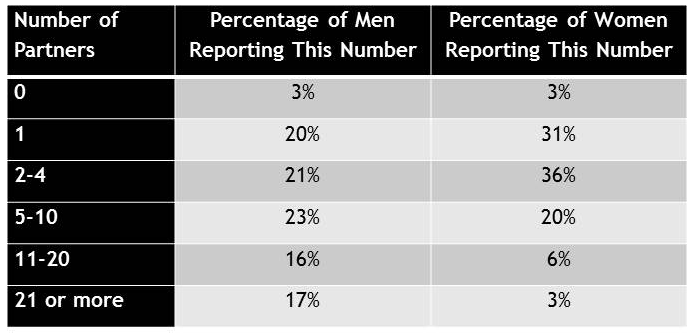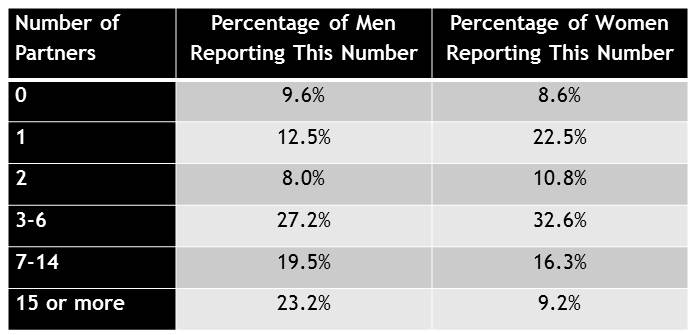Sex Question Friday: What’s Your Number?
June 8, 2012 by Justin Lehmiller
Every Friday on the blog, I answer people’s questions about sex, love, and relationships. This week’s question comes from a college student who wanted to know more about how many sex partners people have during their lives. This is actually one of the most common questions I hear in my Human Sexuality course, so I definitely have an answer!
How many sexual partners do men and women typically have in their lifetime?
Depending upon the specific study you consult, you’ll come to somewhat different conclusions. However, it’s probably best to stick to nationally representative surveys as much as possible for questions of this nature because they likely contain the most reliable information. To that end, I have consulted two studies for you: the National Health and Social Life Survey (NHSLS), which sampled over 3,000 individuals across the United States aged 18 to 59 during the 1990s [1], and the National Survey of Family Growth (NSFG), which surveyed over 13,000 individuals in the U.S. aged 15 to 44 between 2006 and 2008 [2].
I’m going to shy away from talking about averages here because if you’ve ever taken a basic statistics course, you know that averages can be thrown off considerably by a few extreme responses. Thus, if the average is the only number you look at, it can sometimes give you a distorted view of reality. For this reason, I think it’s often more useful to consider a range of responses when describing the frequency of sexual behaviors. If we consider the NHSLS data first, they tell us that most adults are sexually active. Specifically, 97% of men and women reported having had at least one sexual partner during their lives. Overall, the vast majority of men (67%) reported having 10 or fewer total partners, and the vast majority of women (70%) reported having 4 or fewer partners. For a more detailed breakdown of the results, see the table below.
NHSLS: Lifetime Number of Sexual Partners Reported By Men and Women

If we look at the more recent NSFG, we see a similar pattern of results. However, please keep in mind that participants’ ages differed across these two studies (15 to 44 in the NSFG vs. 18 to 59 in the NHSLS), and the researchers used different response options when they asked about number of partners. The findings are thus not completely comparable, but they paint a similar picture. Again, the vast majority of participants were sexually active (more than 90% of men and women), and most men (57.3%) and women (74.55) reported having fewer than 6 lifetime partners. For complete results, see the table below.
NSFG: Lifetime Number of Sexual Partners Reported By Men and Women

You probably noticed in both studies that there’s a pretty consistent sex difference: women are much more likely to report having had only one partner, and men are much more likely to report having had partners in the double digits. Why is this the case? No one knows for sure, but it could be due to many factors. For instance, perhaps men feel social pressure to overreport, whereas women feel pressure to underreport. It could also be that men and women define “sexual partner” in very different ways and are counting different kinds of sexual activities. It could also be that gay and bisexual men have more partners than lesbian and bisexual women, and that skews the results. One or all of these factors may play a role in why men and women tend to give such different answers when asked “what’s your number?”
For previous editions of Sex Question Friday, click here. To send in a question for a future edition, click here.
Want to learn more about Sex and Psychology? Click here for previous articles or follow the blog on Facebook (facebook.com/psychologyofsex), Twitter (@JustinLehmiller), or Reddit (reddit.com/r/psychologyofsex) to receive updates.
[1] Laumann, E. O., Gagnon, J., Michael, R., & Michaels, S. (1994). The social organization of sexuality: Sexual practices in the United States. Chicago: University of Chicago Press.
[2] Chandra, A., Mosher, W. D., & Copen, C. (2011). Sexual behavior, sexual attraction, and sexual identity in the United States: Data from the 2006-2008 National Survey of Family Growth. National Health Statistics Reports, 36, 1-36.
Image Source: 123rf.com

Dr. Justin Lehmiller
Founder & Owner of Sex and PsychologyDr. Justin Lehmiller is a social psychologist and Research Fellow at The Kinsey Institute. He runs the Sex and Psychology blog and podcast and is author of the popular book Tell Me What You Want. Dr. Lehmiller is an award-winning educator, and a prolific researcher who has published more than 50 academic works.
Read full bio >


